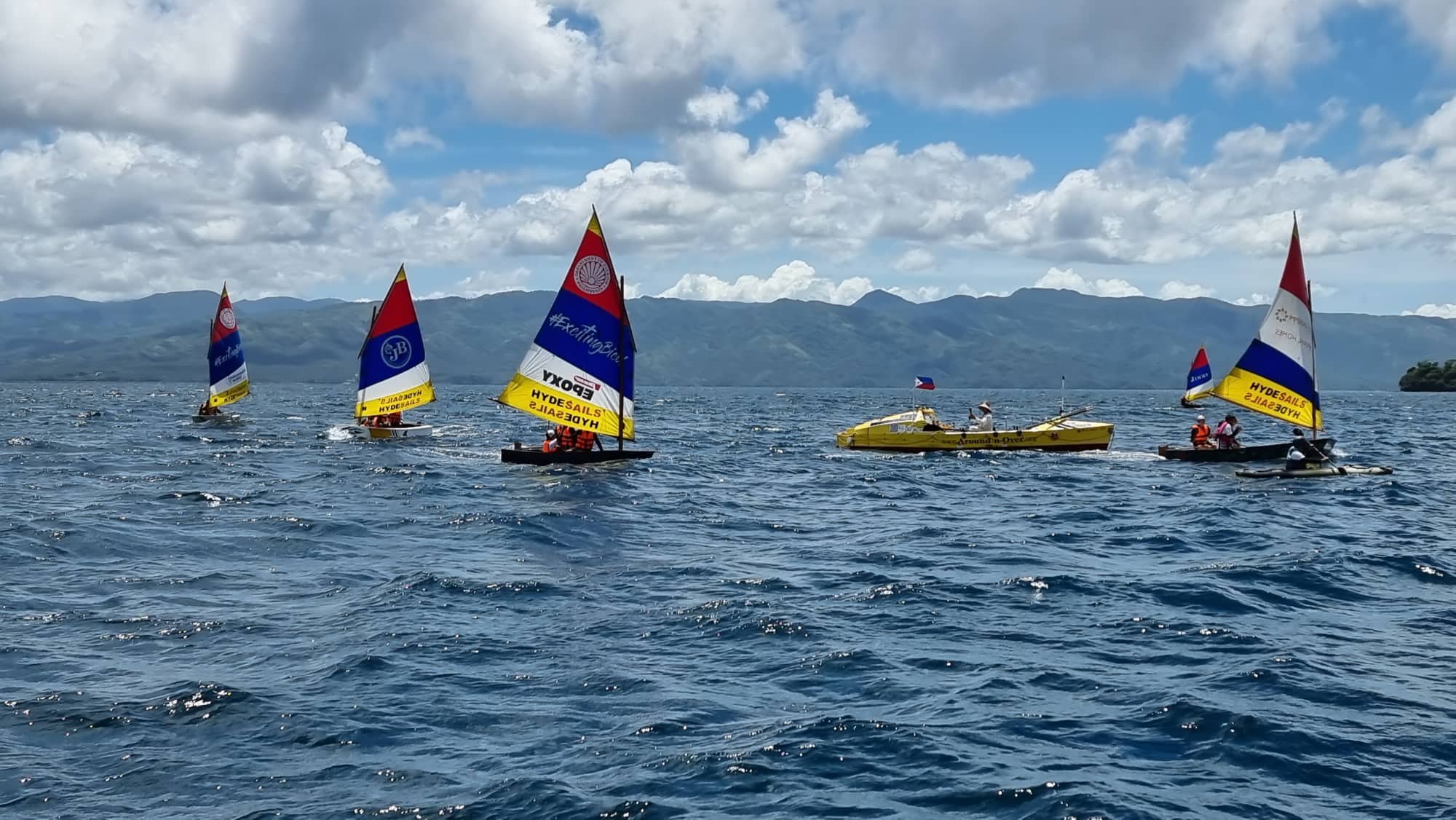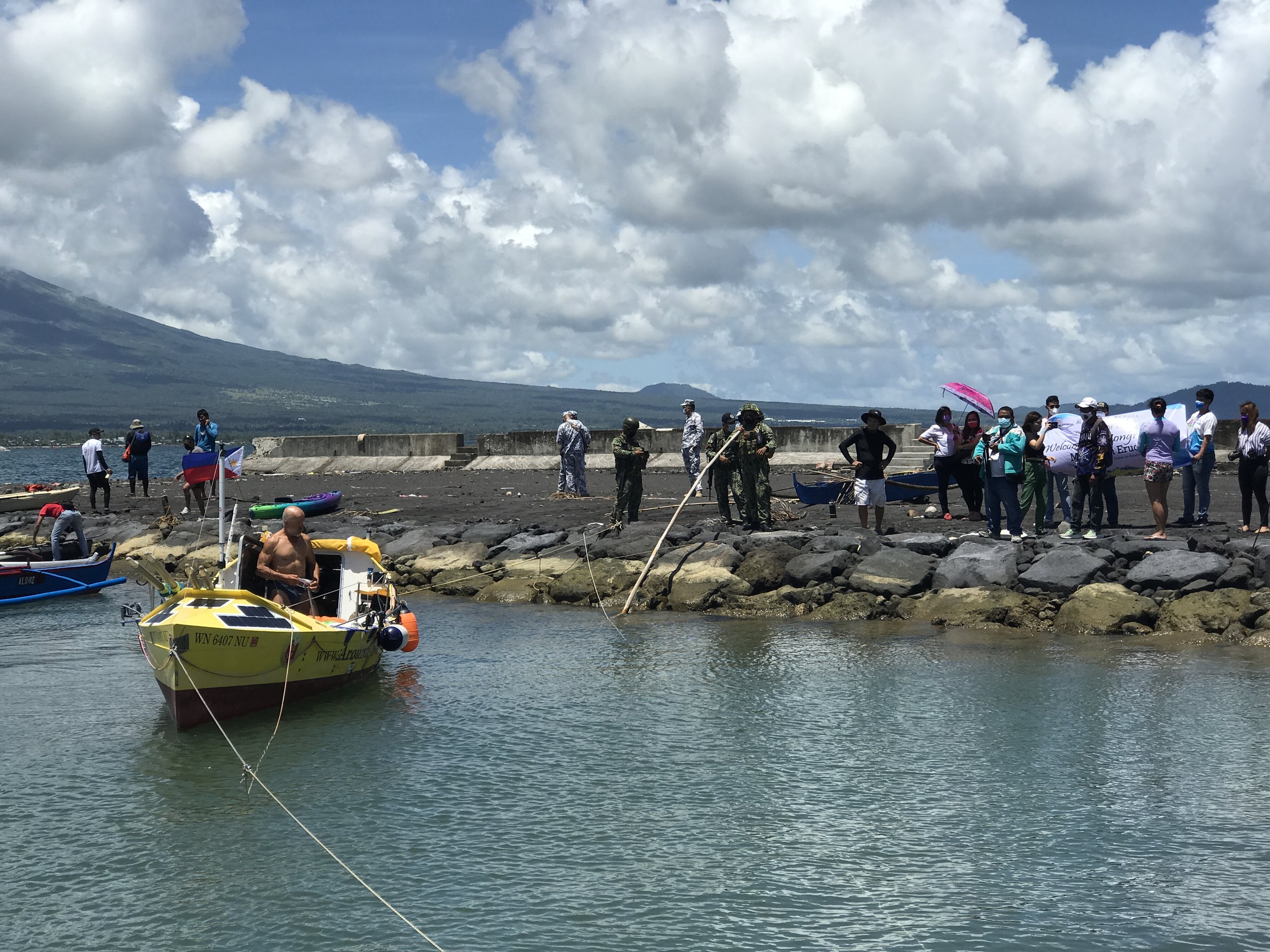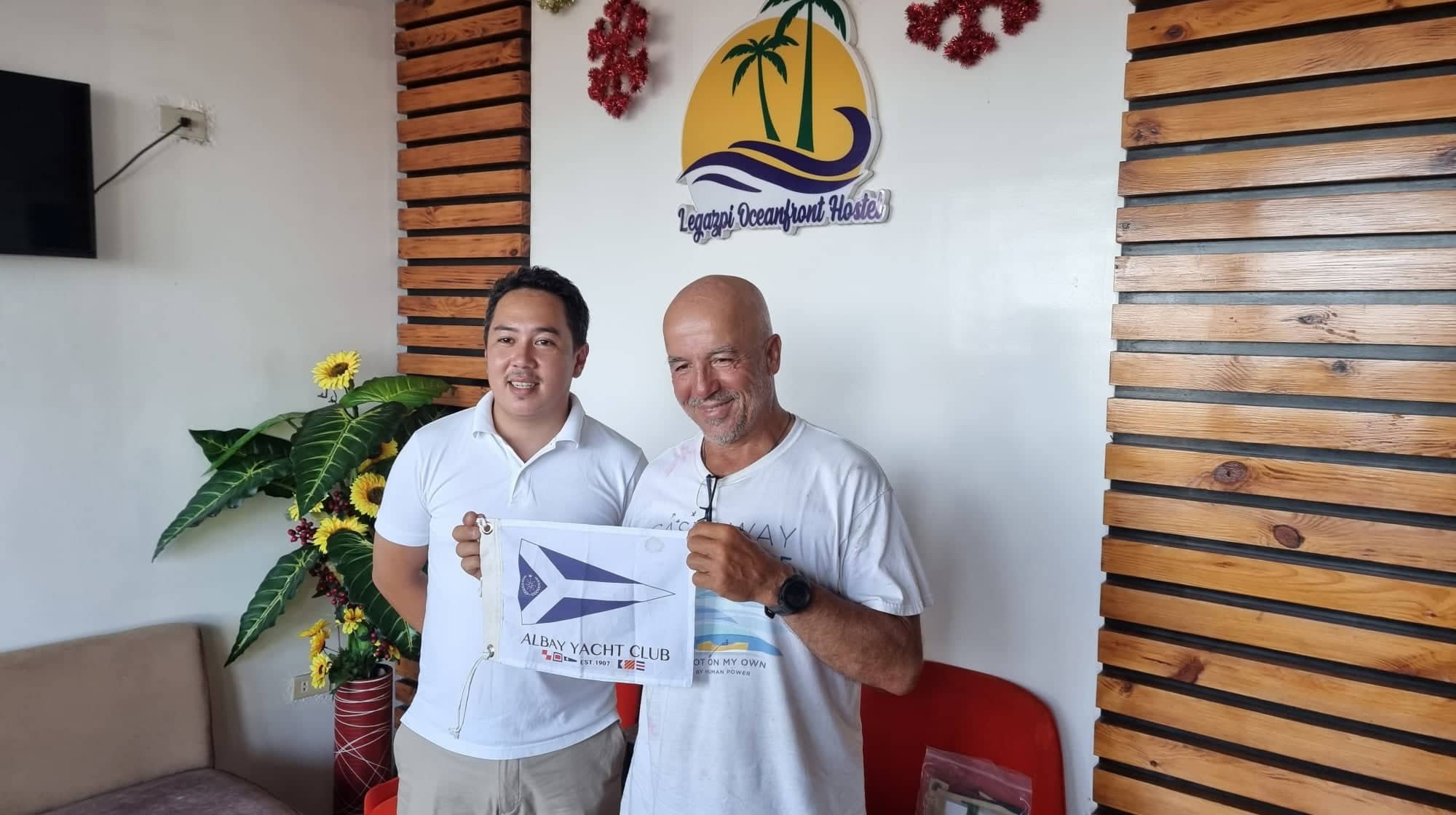Landfall at Legazpi!
Day: 31 — Position: N13 08’ E123 46’
Odometer since Guam: about 1,278M
Distance to Legazpi in the Philippines: 0M
OCEAN ROWING RECORDS AS RUNNING TOTALS
Solo career total in days: 1,084 (New World Record)
Overall career total in days: 1,168 (New World Record)
Solo career total in miles: about 26,697M (New World Record)
**Note: Circumference of the Earth along the equator is 21,600M long
———oOo———
I have been delinquent in posting since my arrival at Legazpi. I apologize. I owe an update to everyone who cheered me on and recognize those who supported me especially in the Philippines.
I made landfall at Legazpi in the Philippines around 13:20 local time on 24 March 2022. Legazpi is a seaside town located at the west end of Albay Gulf at the southeast end of Luzon Island. That landing was not trivial.
I was approaching from the east toward San Bernardino Strait which is between two of the major islands in the Philippines -- Luzon Island to its northwest and Samar Island to its southeast. In order to reach Legazpi, I had to avoid being swept into that strait by strong currents which can run through there like a river. It would have been difficult to control my destiny had I allowed the seas to take charge of my rowboat.
A strong current threatened to carry my rowboat into the San Bernardino Strait.
The last 72 hours before my arrival at Legazpi proved demanding. I had northeasterly winds which conspired with the currents. I had to remain on the outer edges of the current, keeping away from Samar Island to my south but not so far away that I would be carried further north missing the entrance to Albay Gulf.
I had to maintain my distance from Samar Island to line up the entrance to Albay Gulf.
After a 40-hour nonstop effort, I entered the Albay Gulf where the current diminished and I could finally rest. I had been singing at the top of my lungs to keep sleep at bay, shaking my head every now and then to snap awake. Just laying down after being upright by the oars for so long was a relief, let alone sleeping. I could not dare oversleep though; the winds were still carrying the rowboat at just over a knot speed. I set two separate alarms, one by an alarm clock and another by my smart phone, to wake me up after an hour. I woke up to monitor the boat's behavior then reset the alarms for another hour. I repeated this three times then it was time to carry on once again...
Mount Mayon became more prominent as I approached Legazpi.
12 more hours of rowing ensued, favoring the south side of Albay Gulf to line up my approach with Legazpi. The perfect cone of Mount Mayon, an active volcano located north of Legazpi made brief appearances to my west above the cloud cover, becoming more impressive over time giving me a sense of progress.
I had been in contact with Councilman Gregorio Fernand Imperial who had asked me what I craved. My answer was "fresh fruits, green salad and cold drinks." The small pleasure craft Mayon Explorer came looking for me that afternoon; John & Shirley Gochenouer, proprietors of Legazpi Waterfront Hostel, owned the vessel. John was an officer of the Albay Yacht Club, councilman was on their board of directors. My friend Adrian Belic had been in the Philippines ever since the pandemic started, so he made the trek to Legazpi and found John.
Shirley and the rest of them were all on board as they came alongside to hand over a cooler. In it were neatly sliced mangos, papayas, apples, pineapples, cucumbers, all packaged in small ziplock bags along with cans of soda and fruit juices stacked among blocks of ice. I rejoiced as I satiated my thirst and cravings, all the while wondering whether my bowels would be bothered by so much fruit and cold cucumbers chased with ice cold water.
Please see the ARRIVAL VIDEO that John Gochenouer shared on his YouTube Channel.
Enjoying some chilled and sliced papayas, courtesy of Legazpi Oceanfront Hostel.
The last sunset before landfall at Legazpi.
All afternoon, rain over land to my south created squalls from my southeast which threatened to set me off course. When I reached the headland before the small town of Manito just after sunset, I was greeted by an opposing current which slowed my progress down to half a knot boat speed. The shore was just half a mile to my south, stretching for another three miles to my west. Northeast winds were pressing me against what had now become a threatening lee shore. I did not know whether that current was an ebb tide which would reverse or it was due to the northeast winds creating a CCW circulation inside the gulf, in which case it would remain; the answer did not matter at that moment. Rowing another six hours to clear this lee shore was out of the question, I was tired.
Legazpi was at the west end of Albay Gulf.
When my depth gauge finally read 50 meters (165 feet), I decided to drop anchor. I had two rode lines, 200 feet and 150 feet in length respectively. A 15-lbs plow anchor and 15 feet of light chain completed my kit. Anticipating that I would drop anchor, I had already prepared my ground tackle with 200 feet of rode line. Using the 150 feet line, I extended my rode line to 350 feet and dangled the anchor over the edge. Soon the boat came to a stop, and I could relax. Lights of Legazpi were just 8 miles to my west.
I had planned to stay at anchor for six hours such that if I woke up at 04:00 local time, I could reach Legazpi by mid-morning. I stepped outside in the dark to pull up my anchor, but it was set firmly at the bottom. Perhaps I should have kept the rode line at 200-ft, I muttered as I strained to stand up using my legs with a shoulder belay; it was hopeless. Unable to position my rowboat above the anchor, the chain probably did not even lift so the shank of the anchor remained level. Had I been with another rower, perhaps we could have rowed into the wind to bring the rowboat right on top of the anchor to break its purchase. Perhaps it was fouled by a rock… There was no way to know. With limited options, I decided to sleep a couple more hours before trying again by daylight.
When I woke up, the day was breaking. My two-hour nap had not bestowed me with any novel ideas. There was still a steady 10-15 knot northeasterly breeze. First, I fixed some coffee and had breakfast. Then I prepared my oars and rowing station after which I grabbed my emergency knife from the bulkhead, kept there within reach to cut my leash line in case of entanglement after a roll. I pulled in almost all of 150-ft of the added rode line then the sharp serrated edge of the knife made quick work of it under tension. As soon as the remaining rode line disappeared into the blue depths, I began moving downwind at about 1.5 knots. There was no longer an opposing current, which was a relief.
Puro Sailors in their Oz-Goose dinghies accompanied me until Legazpi.
Martin Reynoso was the first one to find me with his sit-on-top kayak. He and the young Legazpi sailors in their gaff rigged Oz-Goose dinghies, had gone in different directions looking for me. Being the slower one, he had left early and followed a different path. It did not take long for the sailors to join us as well. Soon, these "Puro Sailors" appropriately named after the Puro Beach on the Legazpi waterfront, were dashing around me in their dinghies, sailing to impress. Each boat had two young sailors, excited and happy to be involved in the welcoming activities. Before Martin got too far, I asked him to lend me the small Philippine flag that he was flying on his kayak which I then mounted over my cabin bulkhead.
I later would have a chance to accompany the able Puro sailor Reymar Latoza on a club Oz-Gooze in the Albay Gulf. We even spotted a Whale Shark starting at minute 2:00 — BRIEF VIDEO.
I had been told that officers from each of Health Department, Customs, Immigration and representatives of the Tourism Bureau would be ready to receive me in the Banca Harbor. They were waiting under a tent on the breakwater which was set up to process my arrival. Knowing that they would be there mid day, I had a deadline to be ashore in a timely manner.
I had difficulty identifying the breakwater for the Banca Harbor from a distance.
A couple miles short of the harbor, a Philippine Coast Guard skif with officers on board came alongside. I asked them where the harbor was since it was not obvious from my vantage point. They kept a short distance behind my vessel pointing the way. Eventually, I rounded the corner of a T-shaped breakwater into shallower waters where the bancas were tied. These are long slender fishing and commercial vessels which have bamboo outriggers on each side for stability - a trimaran setup which makes them especially wide. Each banca was tied bow and stern to shore and to a buoy to keep them apart. I rowed into the corner where I also could tie my boat bow and stern.
Philippine Coast Guard skiff which guided me to the Banca Harbor.
I was in relatively deep water. I had a gallon of fresh water in a bottle. I placed my passport and other papers, camera, dry change of clothes and a towel in dry bags. I stripped down to my underwear to swim the remaining 8 meters to the breakwater. I first pushed the gallon bottle of fresh water and put it on the piled rocks. Then I returned for my dry bags, swimming back to shore each time. I gingerly stepped on the slick rocks stacked against the water, the surface above which was dirt and eventually concrete. Four gendarmes each in camo gear, helmet, bullet proof vest, extra magazines and an automatic weapon, were waiting to receive me. They kept me in their center as we walked toward the tent. I was moving carefully minding my sea legs.
Martin Reynoso was kind to lend me the Philippine flag from his sit-on-top kayak. I had been rowing in white SPF rated long sleeve shirt and long johns to manage the tropical sun.
We tied my rowboat in the corner of the T-shaped breakwater among the bancas with two lines, one from the stern and another from the bow.
Without a dock, the remaining 8 meters or so required a swim.
I swam the short distance to shore three times, first with a bottle of fresh water to rinse, then with two dry bags carrying a change of clothes and my camera.
Once on the concrete, I rinsed all over using the gallon of water then dried and changed into a clean tshirt and shorts. Everyone under the tent had to be amused by this circus surrounding my landfall. Once presentable, I joined them under the tent and the process started. Health Department verified that I had all my COVID vaccinations. I felt at ease having already received my booster shot in Guam. Immigration stamped my passport, Customs reviewed my papers then gave me an arrival sheet and asked me to visit their office soonest to complete the rest of the paperwork for my rowboat. We made sure to take pictures with the gendarmes before they carried on to other assignments.
Displaying Explorers Club Flag #97 on arrival. My crossing was designated a Flag Expedition by the Explorers Club after I began collaborating with Dr. Jay Barlow to gather ambient sound data to help in the survey of Beaked Whales. Scientific contribution is essential to receive such recognition. I used a high frequency hydrophone between California and Guam which proved useful.
First the health department staff checked my proof of vaccinations, then Immigration stamped my passport and Customs handled the entry process for my rowboat.
The gendarmes tasked to provide me a secure landfall were in full tactical gear.
My rowboat and John Gochenouer’s Mayon Explorer looked good together.
After a shower at the Legazpi Waterfront Hostel, we were invited to dinner courtesy of Al Francis Bichara, the Governor of the Albay Province. Elections were scheduled soon and I had arrived during their campaign season. After his campaign activities that evening, he greeted us and was gracious to congratulate me in person.
Al Francis Bichara, the Governor of the Albay Province was kind to acknowledge my arrival.
I cannot thank enough John and Shirley for their generosity in hosting me at their hostel while I was in Legazpi. Their circle of friends rallied, we were invited to dinners, media connections and hosting was arranged in Manila.
Councilman Gregorio Fernand Imperial presented me the Albay Yacht Club burgee in the lobby of Legazpi Waterfront Hostel operated by John and Shirley Gochenouer.
Albay Yacht Club had a fenced in grass lot a couple doors from their hostel. It took a few days to figure out how we would move my rowboat to that lot where it would remain under guard. During that time, Apa Ongpin based in Manila who knew the maritime industry, together with Councilman Imperial, helped my rowboat clear Customs. We were lucky that the barge JIF BREIZH by JIF-MAR Offshore Services was in Legazpi Port. They were kind to lift my rowboat off the water and swing it on to a trailer.
The crew of JIF BREIZH made quick work of lifting my rowboat from one side then swinging it on John’s trailer.
This is how I left my rowboat on the Albay Yacht Club lot.
By now, the Albay Yacht Club has built a typhoon rated weather shelter over my rowboat.
Once the rowboat was secured on the club's lot, I could make plans to return home. Shirley's friend Terese Lumbao connected me with media in Manila then her friend Dinand Bravo there hosted me for a few days until Apa Ongpin could offer me his condo to stay until my flight.
John and Shirley generously hosted me at the Legazpi Waterfront Hostel then dropped me off at the Bicol International Airport for my flight to Manila.
During that time, I visited the headquarters of Frabelle Corporation to pay my respects to their owner and president Francisco Tiu Laurel, Jr who had graciously offered the assistance of their fishing fleet while I was in Papua New Guinea waters. They picked me up with my rowboat in May 2008, stored it in General Santos City on Mindanao then returned us to the same spot in January 2009 after the typhoon season. Such a logistical feat would have been out of the question without Frabelle's participation and I would most likely have lost my rowboat.
My time on Frabelle's vessels then around their facilities on land, exposed me to the modesty and kindness of Philippine culture. My experience surrounding my recent landfall at Legazpi was not any different. I will forever be grateful.

























